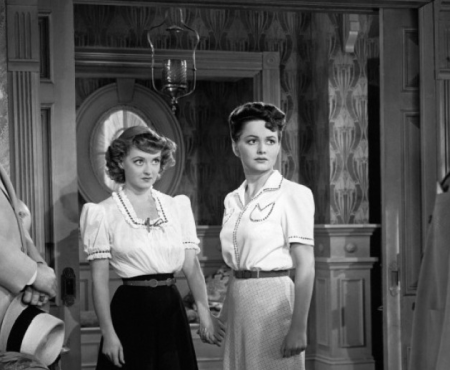Think of Spencer Tracy and Katharine Hepburn together, and battle-of-the-sexes comic snap promptly springs to mind. Cherished by cinephiles for the warm and tart badinage of Woman of the Year, Adam’s Rib and Pat and Mike, their onscreen collaboration endured as an idealized opposites-attract romance that seemed made for the Hollywood factory of dreams. Just as their real-life relationship did not starve for tension, however, so did their cinematic pairings reveal shadow-sides beyond the sass of their beloved romps. The 1947 drama The Sea of Grass presents a marriage fraught with anxiety, while their 1967 swansong Guess Who’s Coming to Dinner can’t help but confront the very mortality of their bond. But it is 1942’s Keeper of the Flame, their second movie together, that offers the richest dark undercurrent in the Tracy-Hepburn canon.
The story opens with the nation in a sorrowing mood: Crowds gather in grief following the death of Robert Forrest: entrepreneur, founder of the patriotic “Forward America” movement, and all-around awe-inspiring icon. Recently returned from overseas, war correspondent Steven O’Malley (Tracy) heads over to the funeral to find swarms of reporters bumping against the gates of the secretive Forrest estate. He’s determined to write about “the real Robert Forrest,” but the official story given by the press secretary (Richard Whorf) is nothing more than a mélange of photograph albums and recorded speeches. Instead, O’Malley has his sights set on the man’s reclusive widow Christine (Hepburn), first seen gravely adorning her husband’s portrait with white flowers. (The glowering fellow in the painting, incidentally, suggests a James Bond villain far more than the “simple, homely, Lincoln-like quality” described by the secretary.)
Keeper of the Flame is structured like the protagonist’s dogged investigation, following O’Malley from character to character as he gleams curlicues of info regarding a man’s life. The resemblance to Citizen Kane is not lost on modern critics, and, like that Orson Welles thunderbolt, the film sports a noir palette. MGM was a studio that specialized in satin and pearls, but here that genteel grayness gets unsettled by swaths of escalating blackness. Credit the times: By 1942, the war that once seemed distant had struck frighteningly close to home and made fascism a palpable, looming menace. Early in the film, O’Malley runs into a fellow journalist (Audrey Christie) and the joy of reunion is undercut when she notices the heaviness in his eyes: “You’ve seen an awful lot over there, haven’t you?” The full extent of wartime horrors was still unknown, but the feeling of dismay was already crystalline.
Without giving too much of the plot away, it’s safe to put the film alongside paranoid thrillers like Hitchcock’s Shadow of a Doubt or Welles’ The Stranger—wartime visions vibrating with the dread of infiltration. Still, Keeper of the Flame is most intriguing in how it relates less to a subgenre than to the themes that run through the career of its director, George Cukor. Cukor started out on the stage, and the sense of theatricality, of characters seeing the world as a proscenium where their inner personas are boisterously projected, never left him. Role-playing and deceit (along with self-deceit) abound in his films, from Hepburn posing in boyish drag in Sylvia Scarlett to Judy Garland rushing from one pantomime to another in the 1954 version of A Star Is Born. People often live in dreams, which of course means that the flipside nightmare is never far off. (Think of Charles Boyer’s sadistic machinations in Gaslight, or Ronald Coleman’s identity being finally devoured by the part he’s playing in A Double Life.)
There’s plenty of Cukor’s trademark liveliness in the film’s edges. His camera sprints in order to keep up with the snooping reporters in the early sequences, powered by the sarcastic banter between Tracy and Christie. And Cukor’s eye for both new and veteran talent makes for a savory supporting cast: There’s the husky young Forrest Tucker as a saturnine family member, Howard Da Silva’s balefulness as a cagey groundskeeper, future “Pa Kettle” Percy Kilbride as a sly taxi driver, and, best of all, Margaret Wycherly in one thunderous sequence as the dead man’s operatically doddering mother.
At the center, however, Keeper of the Flame remains a somber number, its view of idol-worship (embodied by everything from gushing PR campaigns to feverish “youth clubs”) cracked by suspicion. Once O’Malley ultimately discovers the secret about Forrest’s true intentions, the quintessentially American need for heroes is rattled to its foundations. The political murkiness of such a scenario might feel incongruous coming from Louis B. Mayer, who ran MGM like a well-oiled benevolence dispenser, but it fits ideally with Cukor’s fascination with conflicting inner and outer emotional spaces.
Though adapted by The Philadelphia Story screenwriter Donald Ogden Stewart, Keeper of the Flame has little use for romance. It’s not until nearly a third of it is over before Hepburn is introduced, and her character never really develops an amorous connection with Tracy’s sleuthing journalist. (In fact, Hepburn reportedly complained to Mayer about the story’s unrelenting seriousness.) The dearth of passionate chemistry might explain the film’s lowly status among Tracy-Hepburn buffs, yet the uneasy distance between O’Malley and Christine works effectively in this portrait of obscured facades and relationships tainted by mistrust. That Cukor would go on to direct them in both Adam’s Rib and Pat and Mike is less strange than it might at first seem—maybe it takes the man who saw the couple at their lightest to see them at their darkest.




















